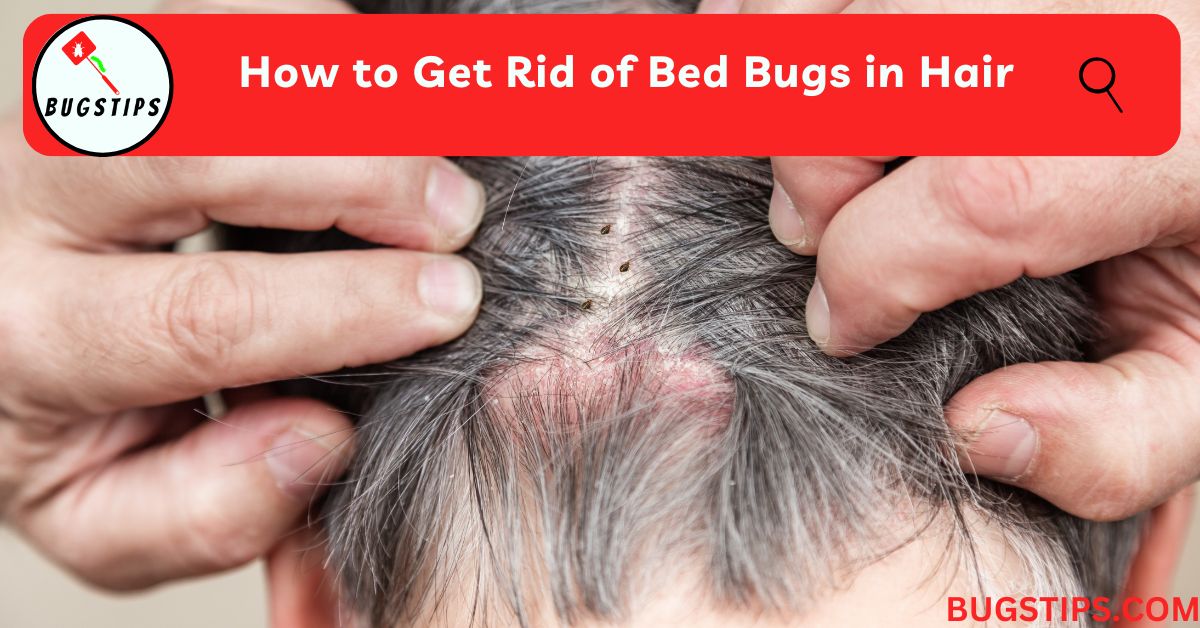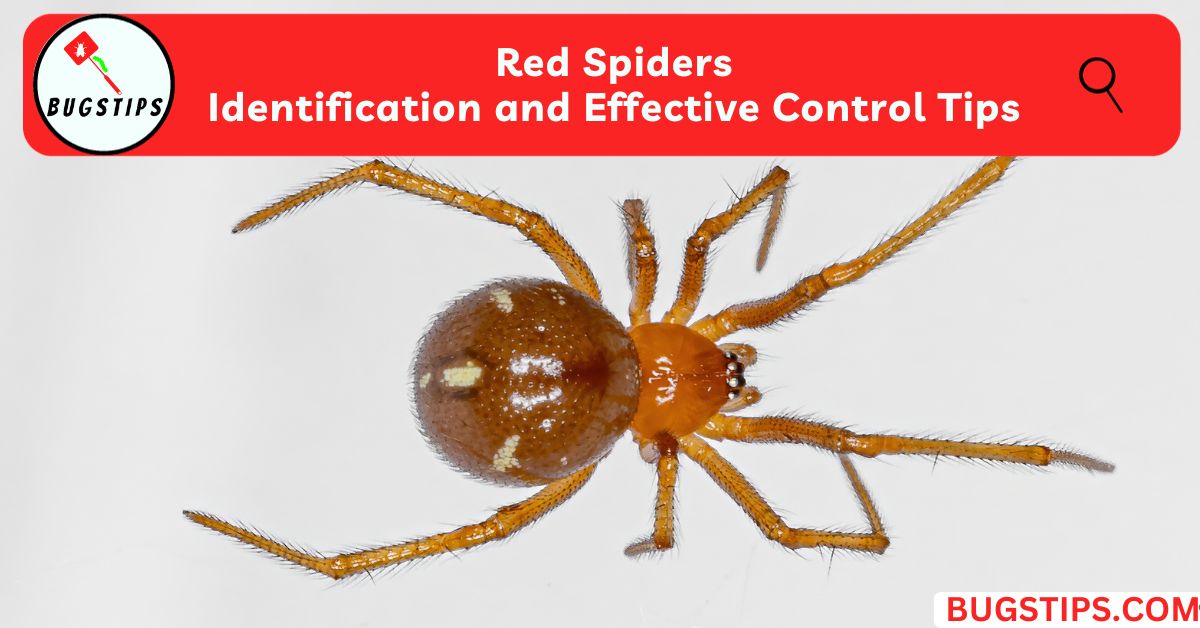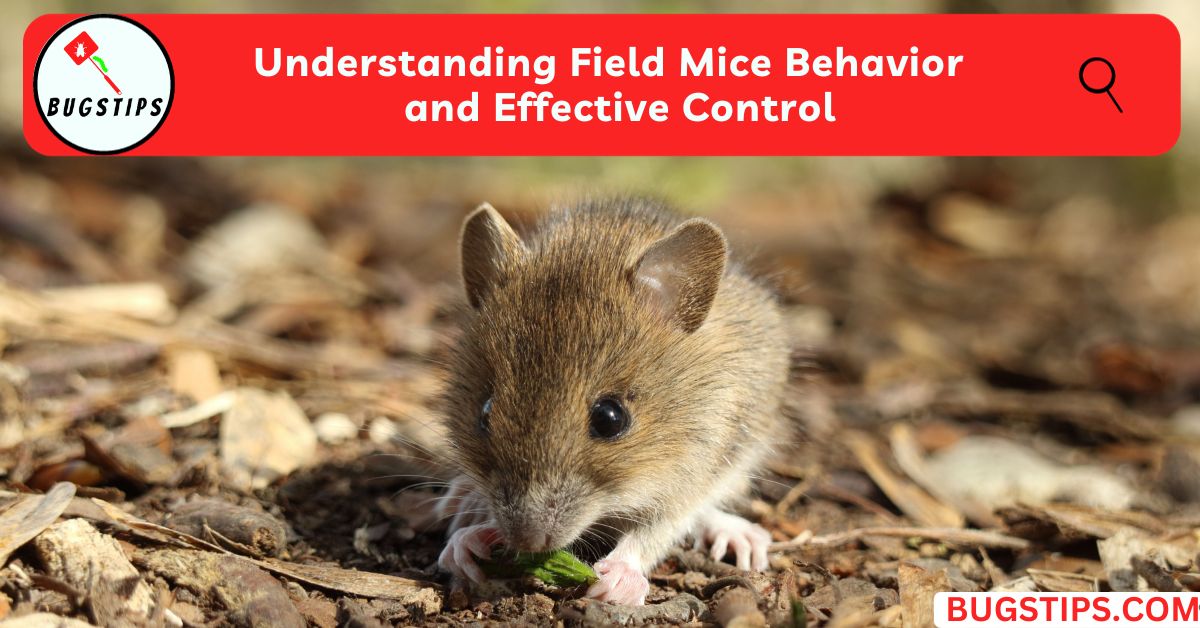This post may contain affiliate links which means as an Amazon Associate, this site may earn a small commission on qualified purchases made through links at no extra cost to you. Learn more on Affiliate Disclosure
You’ve noticed hundreds of tiny black bugs crawling all over the ground in your backyard.
At first glance, they look like ants, but upon closer inspection, you realize they are much smaller. What are these pesky insects? You’re reading this article because you’ve likely noticed an invasion of these annoying critters around your home but aren’t sure what they are or how to get rid of them.
If your yard is swarming with tiny black insects, you’re probably dealing with false chinch bugs.
This article will cover everything you need to know about identifying false chinch bugs and effective ways to banish them from your property so you can get your yard back to being pest-free.
We’ll discuss precisely what false chinch bugs are, why they may be especially prevalent in your area compared to true chinch bugs, how to tell them apart from other similar insects, whether they’re harmful, and most importantly, proven methods to kick them off your property and keep them from returning.
With the proper knowledge, you can rid your yard of these nuisance pests for good.
What Are False Chinch Bugs?

The tiny black insects swarming your yard are known as false chinch bugs. Their scientific name is Nysius raphanus. They belong to the insect family Lygaeidae, which consists of seed bugs and milkweed bugs.
False chinch bugs get their name because they closely resemble another type of bug called the chinch bug. However, false chinch bugs are an entirely different species.
You’ll find them swarming in grassy areas, weedy fields, pastures, foothills, and other open spaces.
False chinch bugs are also sometimes referred to as false stink bugs. Like stink bugs, they can emit an unpleasant odor when disturbed or squashed.
Related Article – White Bugs on Plants
Why Are There False Chinch Bugs?
If you’ve noticed a swarm of false chinch bugs taking over your yard, you’re dealing with a common pest in certain western states.
False chinch bugs are especially prevalent in Arizona, Northern California, Utah, and other warm, arid regions. The hot, dry climates in these areas provide ideal conditions for false chinch bugs to thrive and reproduce rapidly.
Drought years typically see an explosion of these pests as they are able to breed more successfully when moisture is scarce.
False chinch bugs prefer habitats with sparse vegetation, such as foothills, fields, and desert landscapes. Their populations can balloon when they spill over from these environments into neighboring yards.
While many parts of the country may get false chinch bugs, they are a particularly abundant seasonal pest in warm, dry western states. Keep an eye out for these tiny insects if you live in an area that suits their needs.
Related Article – 8 Bugs That Look Like Flying Termites
What’s the Difference Between Chinch Bugs and False Chinch Bugs?
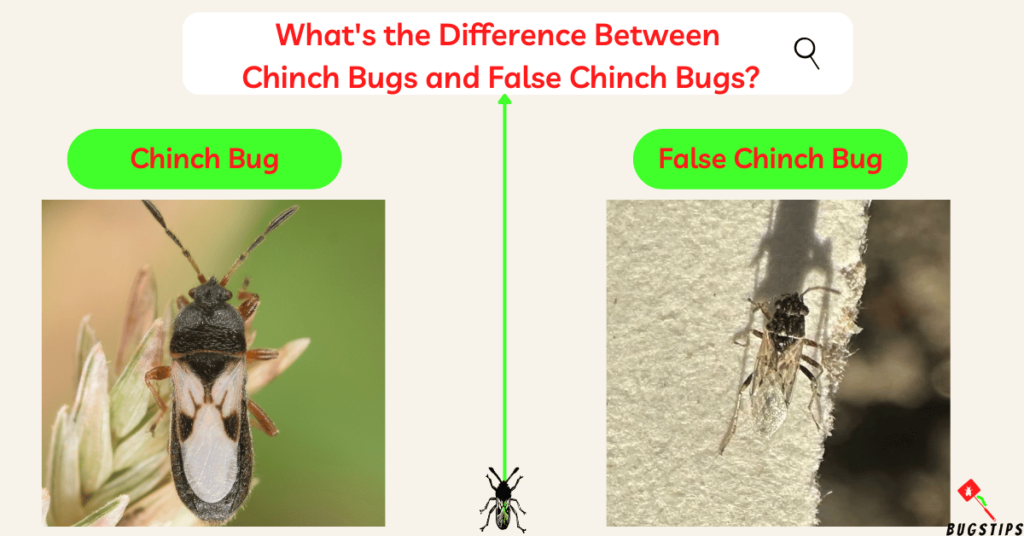
False chinch bugs are often confused with their lookalike cousins, chinch bugs. But despite the similar name, these are two distinct insects.
Here is a helpful table outlining the key differences between chinch bugs and false chinch bugs.
Chinch bug vs. Flase Chinch Bug
| Feature | Chinch Bugs | False Chinch Bugs |
| Scientific Family | Blissidae | Lygaeidae |
| Size | Up to 1/5 inch long | Around 1/8 inch long |
| Color | Black bodies, white wings | Grayish-brown bodies, transparent wings |
| Diet | Grasses | Variety of plants, including weeds |
| Habitat | Humid, dense grass | Dry, sparse vegetation |
| Behavior | Bite humans | Do not bite |
While adult chinch bugs are black, false chinch bugs are a brownish-gray color.
False chinch bugs also have red markings on their bodies while young, which acts as camouflage.
Importantly, chinch bugs will bite humans if they mistake leg hair for blades of grass.
False chinch bugs do not bite and are harmless to people.
As you can see, despite their similar names, chinch bugs and false chinch bugs have distinct sizes, colors, behaviors, diets, and habitats. Learning their unique qualities will help you identify the pest bugging your yard.
You May Also Like – Do Thrips Bite?
Are False Chinch Bugs Harmful?
As mentioned previously, false chinch bugs do not bite or pose any harm to people. However, they can potentially damage plants and trees when present in large numbers.
False chinch bugs use their piercing-sucking mouthparts to feed on plant fluids and tissues. They extract sap from stems and leaves.
If many false chinch bugs feed on a plant over time, this can stunt growth by depriving the plant of moisture and nutrients.
Excessive feeding damage becomes more likely if false chinch bug populations explode. Drought conditions often lead to a proliferation of these pests.
Plants stressed by lack of water can be further weakened and even killed off by hordes of false chinch bugs sucking their juices.
While a small number of false chinch bugs is not serious, uncontrolled populations can drain enough plant fluids to injure or kill vegetation.
Home gardens, crops, and tree saplings are most at risk if they become overwhelmed by these tiny pests.
Related Article – 14 Small Tiny Brown Bugs In The House
How Long Do False Chinch Bugs Live?
False chinch bugs are multivoltine insects, meaning they can produce multiple generations in a single year.
Their lifecycle enables their populations to grow rapidly under favorable conditions.
In winter, false chinch bugs survive as nymphs and adults hiding beneath debris or feeding on plants like mustards.
When spring arrives, the adults become active and females begin laying eggs in soil cracks and directly on host plants.
The tiny eggs hatch into nymphs after about 10 days. The nymphs feed for around 3 weeks, going through 5 stages before reaching full adulthood. The total development time from egg to adult is approximately a month.
Once they reach the adult stage, false chinch bugs live for several additional weeks. Multiple generations continuously overlap throughout spring, summer, and fall. The adults cluster on preferred host plants to feed and mate during this time.
The lifespan of an individual false chinch bug is fairly short, just a few weeks as an adult.
However, their ability to breed continuously allows their populations to multiply rapidly over a single growing season.
You May Also Like – 8 Bugs That Look Like Lint and Bite
Do False Chinch Bugs Jump?
False chinch bugs are not able to jump very high or far. However, they can make small hops and leaps when disturbed or moving between food sources.
These insects use their legs to propel quick, short jumps. This allows them to scatter when threatened and disperse to new host plants nearby.
The nymphs or juveniles cluster together on plants or the ground. They can hop a few inches if disturbed, but not as far as the adults.
Their jumping habits make controlling these tiny pests more challenging.
Do False Chinch Bugs Fly?
False chinch bugs are capable of flight, but only for short distances. They do not migrate long ranges by flying like some insects.
The adults have wings and can take brief flying leaps a few feet when disturbed or dispersing to new plants. However, they spend most of their time crawling around on the ground or vegetation.
You may see a swarm of false chinch bugs take to the air if the ground is disturbed near them. But these short burst flights just lift them a short way before landing again.
When migrating to new areas, false chinch bugs usually walk and crawl rather than flying.
The wingless nymphs also march along the ground with the adults when expanding territory.
You May Also Like – Can Horse Flies Kill You?
How to Get Rid of False Chinch Bugs
If you find false chinch bugs invading your outdoor or indoor spaces, don’t worry – you can use several effective methods to eliminate these pests.
Here are some practical, tried, and true ways to kick them off your property.
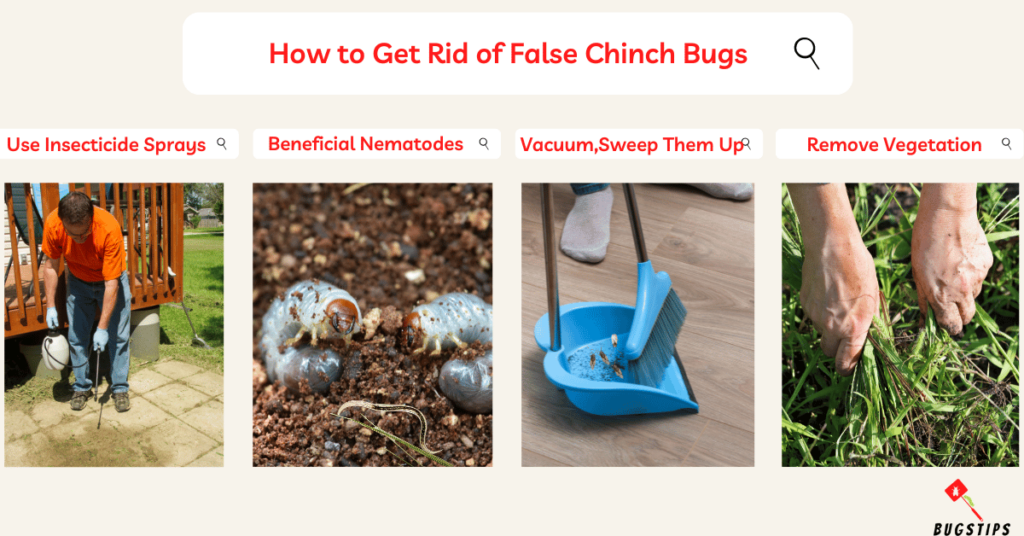
Use Insecticide Sprays
- Insecticide sprays containing bifenthrin or imidacloprid are very effective against active false chinch bug populations in your yard.
- Apply bifenthrin (found in Talstar/Bifen products) as a spray targeting areas where you see false chinch bugs crawling – the thatch layer, soil, grass, and mulched beds.
- This insecticide provides contact kill of the active pests.
- Mix in imidacloprid, which will be absorbed by plant roots.
- This systemic insecticide is taken up into lawn and garden vegetation to kill false chinch bugs when they feed on the plants.
- For optimal results, combine the bifenthrin and imidacloprid and apply according to label rates.
- Water in thoroughly with around 0.25 inches of irrigation so the insecticides penetrate the soil and thatch.
- The bifenthrin targets current bugs, while the imidacloprid provides lasting control as new generations hatch.
You will need to reapply monthly for a few months since eggs can continue hatching for 5-13 weeks.
Apply Beneficial Nematodes
- Releasing beneficial nematodes into your yard provides organic pest control.
- The tiny worms seek out and kill false chinch bugs living in the soil and thatch without harming the environment.
Vacuum or Sweep Them Up
- For isolated invasions inside the home, quickly vacuum or sweep up the insects you see.
- This can help control an indoor infestation before it grows.
- Just be sure to empty the vacuum contents outside afterward.
Remove Vegetation
- Outdoors, keeping your yard free of dense ground cover vegetation, weeds, and thick mulch cuts off habitat and food sources for false chinch bugs.
- Proper landscape maintenance discourages large infestations.
- Eliminating the plants and debris false chinch bugs rely on for food is key because if they have no food sources available, they cannot survive.
Seal Entry Points
- You can also help prevent false chinch bugs from invading your home by using tight-fitting doors and weather stripping to seal potential entry points.
- Make sure doors and windows are properly fitted with no gaps or holes for the insects to crawl through.
- Sealing cracks and crevices deprives false chinch bugs of routes into your indoor living spaces, adding another layer of protection.
Related Article – Bugs in Mailbox: 10 EASY Ways to Keep Them Out
How Long Do False Chinch Bug Swarms Last?
Unfortunately, there’s no set duration for an infestation. It depends on the size of the initial swarm and conditions.
In most cases, false chinch bug swarms only persist for a few days to two weeks before dissipating or moving elsewhere.
Since the adults only live for a matter of weeks, they will die off naturally in that timeframe as long as new generations aren’t being produced.
However, under optimal conditions with plentiful food sources available, false chinch bug swarms may linger longer – occasionally up to 6 weeks in rare circumstances.
The insects can continuously breed and pump out new generations that keep the infestation going.
The best way to cut an infestation short is by using control methods to eliminate food sources and kill off existing bugs.
This prevents ongoing reproduction that allows swarms to drag on. With diligent management, most false chinch bug invasions can be cleared within a couple of weeks.
You May Also Like – 12 Tiny Black Bugs on Window Sill
Final Thoughts
If those tiny black insects swarming your yard turned out to be false chinch bugs, hopefully, this article provided the information you need to identify and control these pesky pests.
While they can be a nuisance, a bit of diligence goes a long way in ridding your property of false chinch bugs.
Remember that keeping your landscape tidy by eliminating thick vegetation and weeds can deprive these insects of food and habitat. Combine plant removal with insecticide applications for the best results.
If an infestation does occur, thorough management can usually knock out the invasion within a couple of weeks.
While often mistaken for close cousins like chinch bugs or stink bugs, false chinch bugs have distinctive behaviors, appearances, and habits as we discussed.
Now that you know precisely what you are dealing with, you can take action to keep these annoying yet harmless insects from taking over your yard.
FAQs
Do false chinch bugs look like ants?
No, false chinch bugs do not look like ants. They are much smaller than ants, around 1/16 – 1/8 inches long. False chinch bugs have grayish-brown bodies whereas ants are typically black or red.
What kills false chinch bugs?
Insecticide sprays and granules containing bifenthrin, and imidacloprid, effectively kill false chinch bugs. Beneficial nematodes also provide organic pest control by infecting and killing them.
How do you get rid of false chinch bugs naturally?
Natural ways to control false chinch bugs include removing vegetation and food sources, applying diatomaceous earth, and Maintaining a tidy landscape to discourage infestations.
How to get rid of false chinch bugs in the house?
To control false chinch bugs inside, vacuum up any visible bugs and dispose of the vacuum bag outside immediately.
Caulk cracks and crevices to remove entry points. Set out sticky traps along walls where they are active.
Resources – (for further reading)
UC IPM – False Chinch Bug Management Guidelines
Colorado State University – False Chinch Bugs – 5.603 – CSU Extension
University of Florida – false chinch bug – Blissus insularis Barbar


